Body length: 8–20 mm.
Eyes: eye interommatidial setaeseta:
a sclerotized hair-like projection of the cuticle
absent, eye entire/shallowly emarginateemarginate:
notched at the margin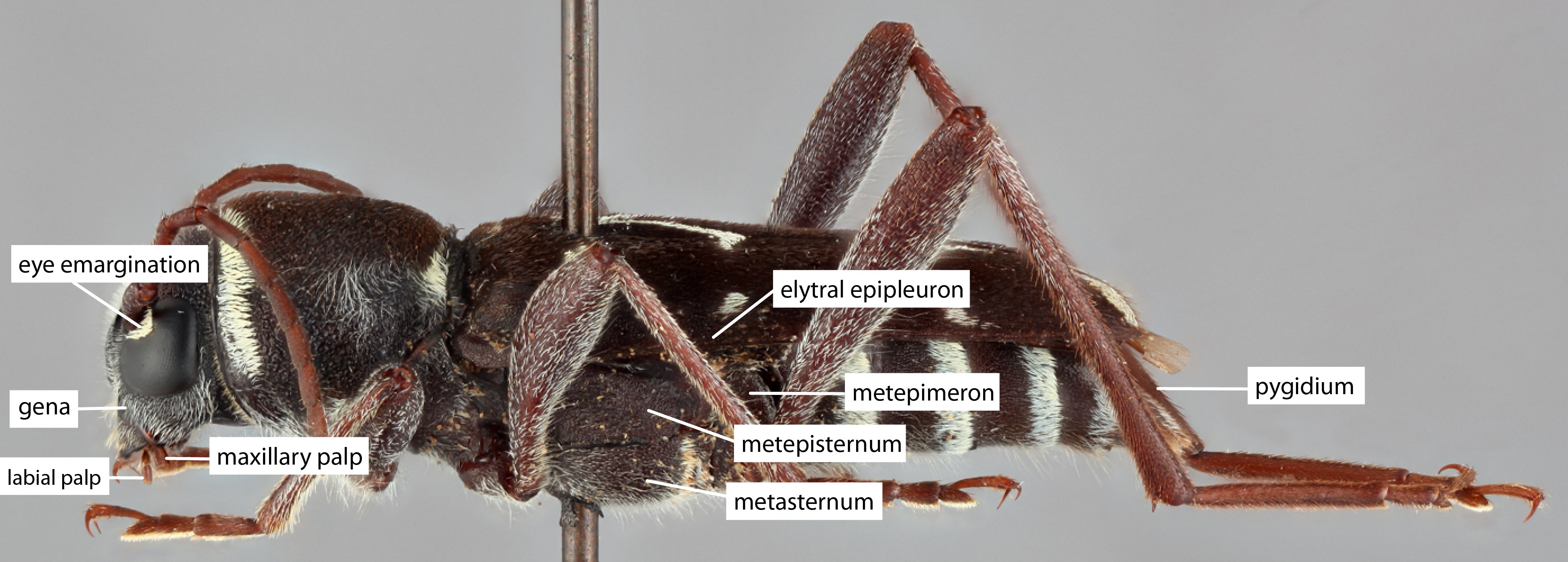 , eye ommatidial density fine.
, eye ommatidial density fine.
Antennaeantenna:
in larval and adult insects, paired segmented appendages, borne one on each side of the head, functioning as sense organs and bearing a large number of sensilla
: antennal length barely surpassing pronotumpronotum:
the upper and dorsal part of the prothorax
or shorter, antennal flagellar segments elongateelongate:
much longer than wide
, rarely quadrate, scapescape:
the first proximal segment of the antenna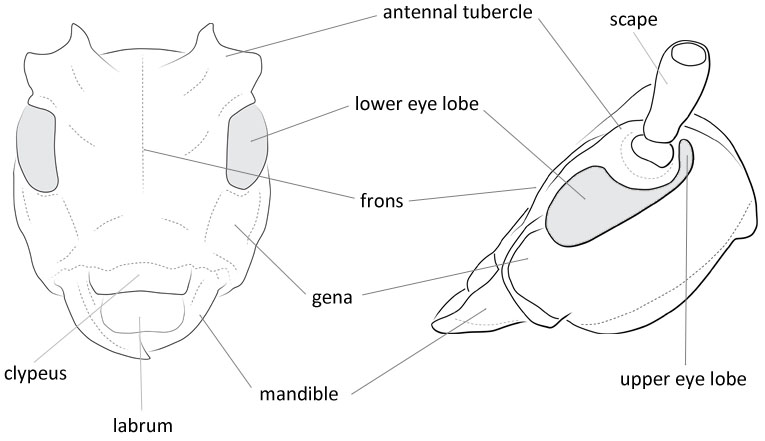 smooth/punctate at apexapex:
smooth/punctate at apexapex:
end of any structure distad to the base
, antennal scapescape:
the first proximal segment of the antenna ≥ segment 3.
≥ segment 3.
Pronotumpronotum:
the upper and dorsal part of the prothorax
: pronotumpronotum:
the upper and dorsal part of the prothorax
shape transversetransverse:
broader than long
, pronotumpronotum:
the upper and dorsal part of the prothorax
lateral armature absent.
Prosternum: prosternal processprosternal process:
a posterior extension of the prosternum between the coxae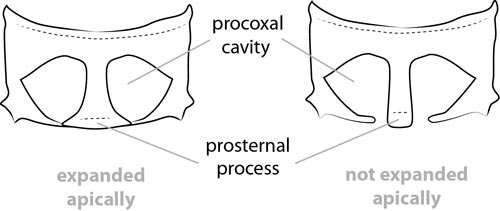 dilated at apexapex:
dilated at apexapex:
end of any structure distad to the base
, rarely not dilated at apexapex:
end of any structure distad to the base
, procoxal cavities closed posteriorly.
Elytraelytron:
the leathery forewing of beetles, serving as a covering for the hind wings, commonly meeting opposite elytron in a straight line down the middle of the dorsum in repose
: elytral length reaching or close to end of abdomen, elytral apicesapex:
end of any structure distad to the base
rounded or truncatetruncate:
cut off squarely at the tip
, elytral color black, brown, or reddish, elytral color pattern absent.
Legs: visible tarsomerestarsomere:
subdivision or article of the tarsus, usually numbering from two to five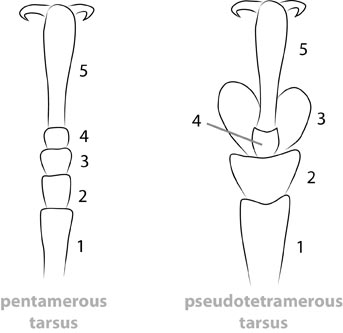 : 5, femora slender or robust, protibial spursprotibial spur:
: 5, femora slender or robust, protibial spursprotibial spur:
sclerotized spine(s) located at the distal tibia; can be single, double, or absent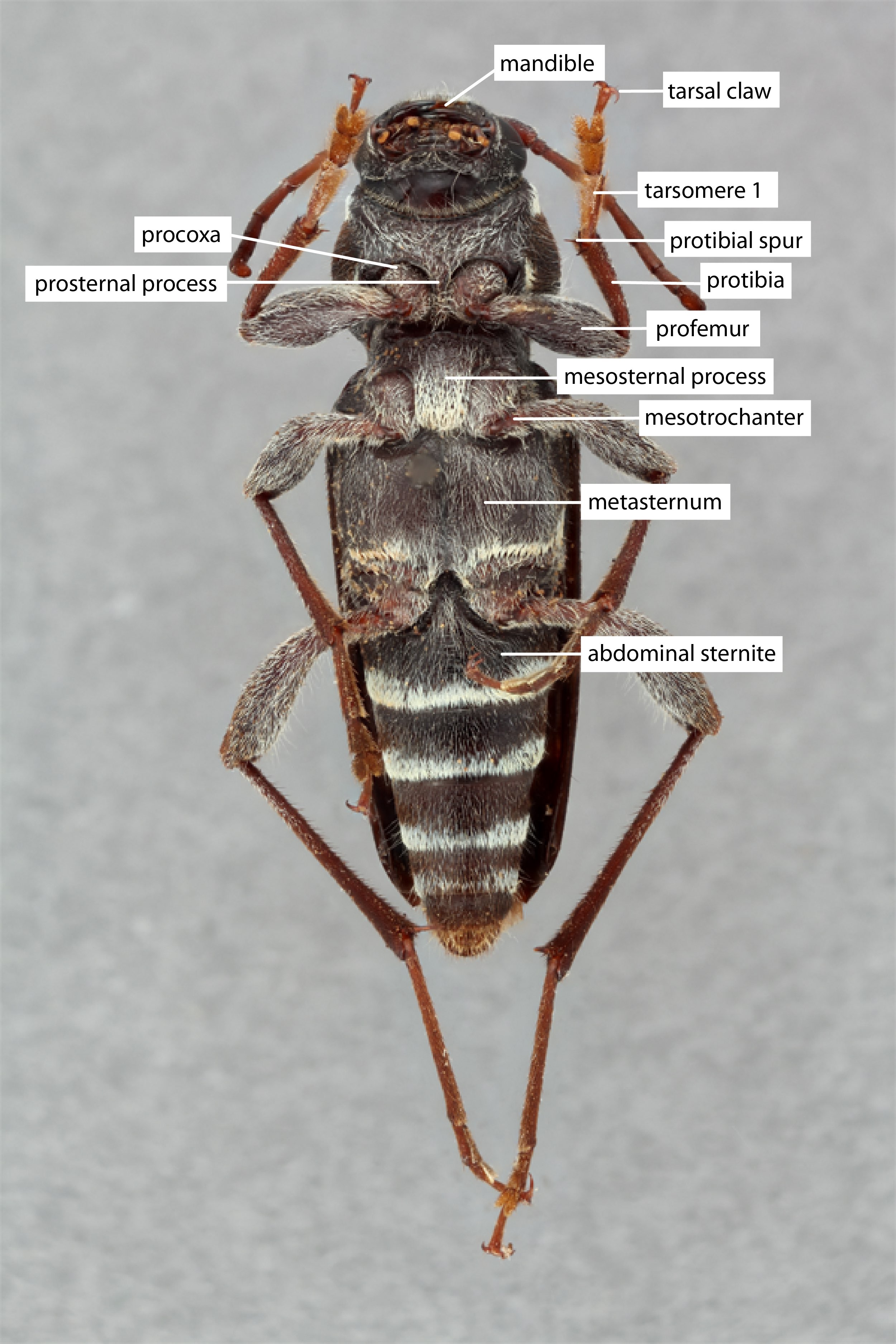 : 2, tarsal clawstarsal claw:
: 2, tarsal clawstarsal claw:
usually paired claws of the pretarsus, at the distal end of the leg simple.
simple.
Head large, almost as broad as pronotumpronotum:
the upper and dorsal part of the prothorax
; mandibles shorter than head, cutting edge with a basal tooth; second segment of maxillary palpi slightly shorter than third; galea transversetransverse:
broader than long
, apically expanded, spatuliform; lacinia vestigial, ligula attenuateattenuate:
gradually tapering apically
, not bilobed apically; antennaeantenna:
in larval and adult insects, paired segmented appendages, borne one on each side of the head, functioning as sense organs and bearing a large number of sensilla
inserted in front of eyes near the basebase:
the part of any appendage or structure that is nearest the body
of pronotumpronotum:
the upper and dorsal part of the prothorax
, not or hardly attaining the basebase:
the part of any appendage or structure that is nearest the body
of elytraelytron:
the leathery forewing of beetles, serving as a covering for the hind wings, commonly meeting opposite elytron in a straight line down the middle of the dorsum in repose
, third segment about twice as long as second, third and fourth segments globose, the following moderately flattened; segments fifth to tenth with two separate small sensory areas at each side of their apexapex:
end of any structure distad to the base
. Pronotumpronotum:
the upper and dorsal part of the prothorax
cordiform, narrowing posteriorly from about apical 1/3. Prosternum distinctly convex in front, with process parallel-sided, strongly expanded apically, coxal cavities strongly angulate laterally, closed behind (pleural and prosternal processes connected but not fused); mesothoracic process not broader than the prosternal one, moderately expanded behind, bilobed at apexapex:
end of any structure distad to the base
; coxal cavities open externally to the epimera; metathoracic episterna very narrow. Each elytronelytron:
the leathery forewing of beetles, serving as a covering for the hind wings, commonly meeting opposite elytron in a straight line down the middle of the dorsum in repose
with 2-3 more or less distinct glabrousglabrous:
smooth, devoid of pubescence; devoid of any sculpturing
costae, sometimes obsolete, rarely absent. Legs short, with hind femora very robust, enlarged; tibiaetibia:
the leg segment distal to the femur, proximal to the tarsus
granulated or finely spined on the outer side; front tibiaetibia:
the leg segment distal to the femur, proximal to the tarsus
densely punctatepunctate:
set with fine, impressed points or punctures appearing as pin-pricks
externally; hind tibiaetibia:
the leg segment distal to the femur, proximal to the tarsus
without a distinct lamella at the outer apexapex:
end of any structure distad to the base
and with two long apical spines (adapted from Sama 2005Sama 2005:
Sama G. 2005. Description of Neospondylis gen. nov. from North America and Mexico (Coleoptera, Cerambycidae, Spondylinae). Les Cahiers Magellanes 43: 1–10, 38 figs.).
The smooth cutting edge of mandibles, closed coxal cavities, non-globose pronotumpronotum:
the upper and dorsal part of the prothorax
, and lack of teeth on the outer edge of tibiaetibia:
the leg segment distal to the femur, proximal to the tarsus
will distinguish Neospondylis from Spondylis.
Spondylis Fabricius differs from Neospondylis as follows: mandibles with small teeth on the cutting edge; second segment of maxillary palpi shorter than third; galea small, digitiform, ligula strongly expanded laterally, deeply bilobed, with or without a prominent median tooth at apexapex:
end of any structure distad to the base
. Pronotumpronotum:
the upper and dorsal part of the prothorax
globose, rounded at sides, shortly parallel-sided before the basebase:
the part of any appendage or structure that is nearest the body
. Antennaeantenna:
in larval and adult insects, paired segmented appendages, borne one on each side of the head, functioning as sense organs and bearing a large number of sensilla
with third segment longer than fourth; segments third to tenth flattened above and with a wide sensory area on the outer side. Prosternum moderately convex in front, with process narrower, parallel sided, slightly expanded apically, coxal cavities open behind (pleural and prosternal processes not connected); mesothoraxmesothorax:
the second or middle thoracic segment bearing the midlegs and the forewings
with process evidently broader than the prosternal one, parallel-sided, not expanded behind, bilobed at apexapex:
end of any structure distad to the base
, episterna distinctly wider. Tibiaetibia:
the leg segment distal to the femur, proximal to the tarsus
on the outer side with several prominent teeth; front tibiaetibia:
the leg segment distal to the femur, proximal to the tarsus
flattened and shining externally; all tibiaetibia:
the leg segment distal to the femur, proximal to the tarsus
with a larger conspicuous lamella on the outer apexapex:
end of any structure distad to the base
(Sama 2005Sama 2005:
Sama G. 2005. Description of Neospondylis gen. nov. from North America and Mexico (Coleoptera, Cerambycidae, Spondylinae). Les Cahiers Magellanes 43: 1–10, 38 figs.).
Nearctic: coniferous forests of North America from Alaska southeast to the Great Lakes region, south into the Rocky Mountains, and along the western coast; Mexico
Picea, Pinus
2 species
Neospondylis Sama, 2005Sama, 2005:
Sama G. 2005. Description of Neospondylis gen. nov. from North America and Mexico (Coleoptera, Cerambycidae, Spondylinae). Les Cahiers Magellanes 43: 1–10, 38 figs.